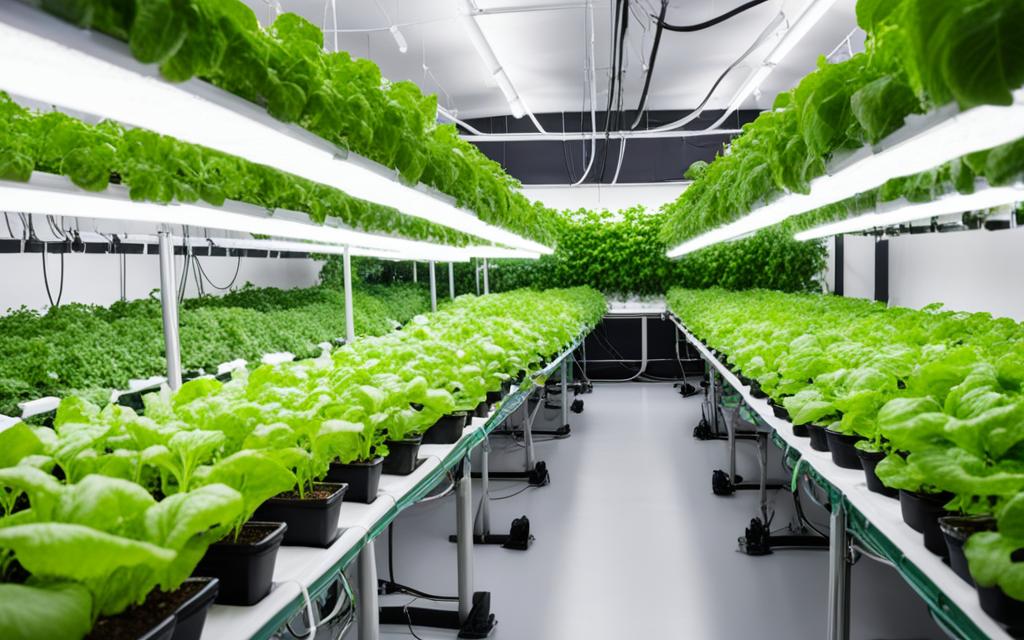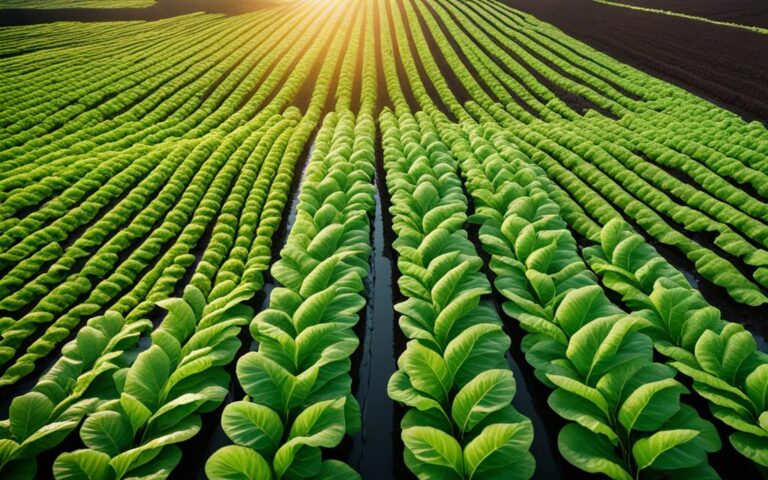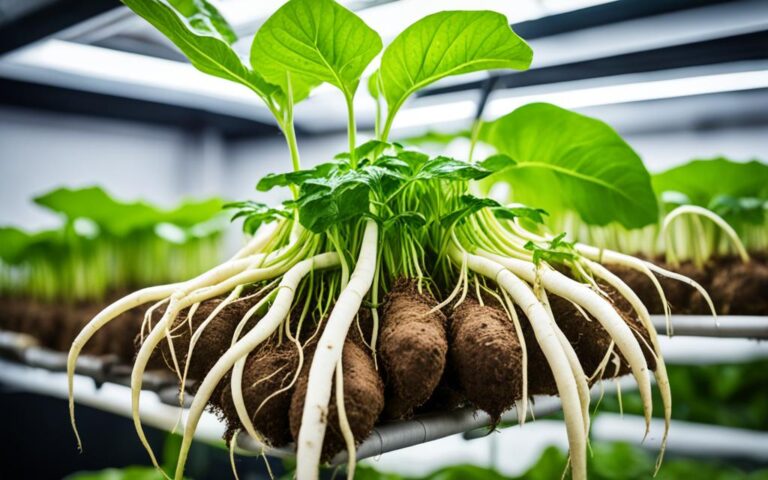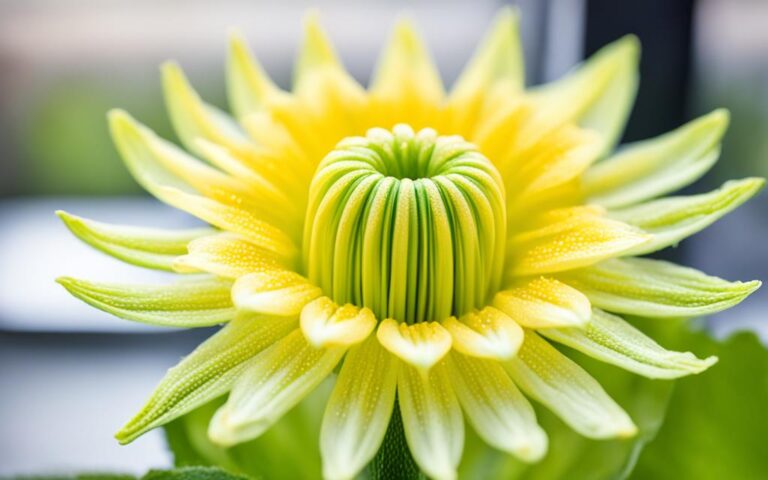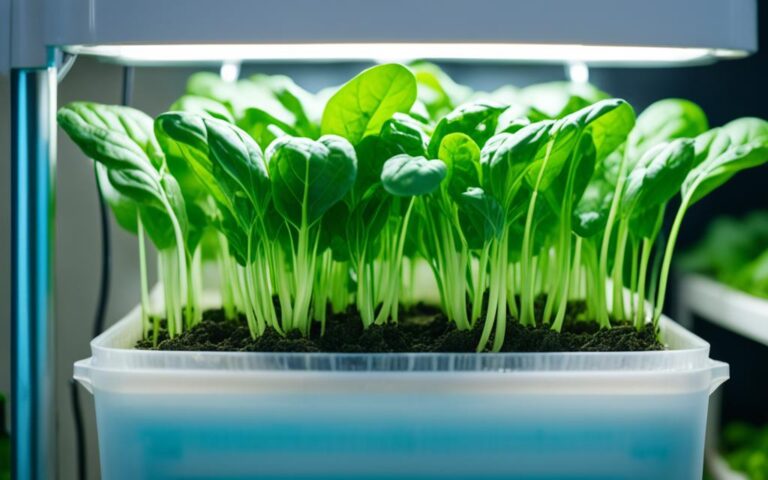Hydroponic Vegetable Garden: Grow Fresh Produce at Home
Imagine picking juicy tomatoes, crisp lettuce, and fragrant herbs from your kitchen. Hydroponic gardening lets you do just that, offering fresh, nutrient-rich produce all year. This guide will take you through the basics of hydroponic vegetable gardening. You’ll learn about the benefits, the various systems available, what you need to get started, and how to grow the best produce.
Hydroponic gardening, or soilless cultivation, is a new way to grow plants. It uses nutrient-rich water instead of soil. This method has many benefits, like pesticide-free produce and the ability to grow food indoors all year.
Key Takeaways
- Hydroponic gardening lets you grow fresh, nutrient-rich produce all year without soil.
- Hydroponic systems feed plants with nutrient-rich water instead of soil.
- This method offers pesticide-free and nutrient-dense harvests and lets you grow produce year-round.
- This guide will cover different hydroponic systems, essential equipment, and tips for better yields.
- Hydroponic gardening is a new way to grow your own fresh produce, even in small spaces.
Table of Contents
Introduction to Hydroponic Vegetable Gardening
Hydroponic vegetable gardening is a way to grow plants without soil. It uses a nutrient-rich water solution for the roots. This method lets plants get the nutrients they need without soil. It’s great for people with little space or who want fresh produce all year.
Hydroponic gardening has many advantages over traditional gardening. Plants grow faster and produce earlier because they get nutrients directly. It also uses space well, letting you grow more plants in a small area. This is perfect for city folks or those with little outdoor space.
There are many types of hydroponic systems, each good for different plants. Passive systems like wick systems are cheaper and work well for small plants. Active systems, like the nutrient film technique (NFT), are better for big plants and automate nutrient supply. Media-based systems, like ebb-and-flow, cost more but are efficient and recycle nutrients.
| Hydroponic System | Characteristics | Suitable Plants |
|---|---|---|
| Wick System | Passive, cost-effective, simple to set up | Herbs, microgreens |
| Water Culture System | Simple, low-cost, suitable for water-loving plants | Leaf lettuce |
| Ebb and Flow System | Media-based, efficient nutrient recycling, versatile | Wide variety of vegetables |
| Nutrient Film Technique (NFT) | Active, constant nutrient flow, suitable for larger plants | Leafy greens, herbs, tomatoes |
Home versions of commercial hydroponic methods offer more yields and less disease and pests. Companies like Hydrofarm help beginners and experts set up top-notch hydroponic systems. They offer a variety of lighting, growing media, and equipment.
Hydroponics is a flexible and new way to grow veggies, herbs, and some fruits indoors or in small outdoor areas. By picking the right hydroponic system, gardeners can meet their needs and enjoy fresh, nutritious produce at home.
Benefits of Growing Vegetables Hydroponically
Hydroponic gardening has many benefits for both home and commercial growers. It lets plants grow in a controlled, soil-free space. This means you get pesticide-free, nutrient-rich produce. Plus, you can grow vegetables all year, no matter the weather outside.
Pesticide-Free and Nutrient-Rich Produce
Hydroponic gardens are great for growing veggies without pesticides. Plants don’t get pests or diseases from the soil. So, you don’t need harmful chemicals. This makes the produce healthier and more natural.
Also, you can control what nutrients the plants get. This ensures they grow strong and are full of vitamins and minerals. The result is veggies that are not just healthy but also taste better.
Year-Round Growing Potential
Hydroponic gardens can grow veggies all year in a controlled space. Unlike traditional gardens, they don’t stop growing with the seasons. You can keep the temperature, light, and moisture just right all year.
This means you always have fresh, local produce. Even in places with tough weather or short growing seasons. It’s a reliable way to get healthy food all year.
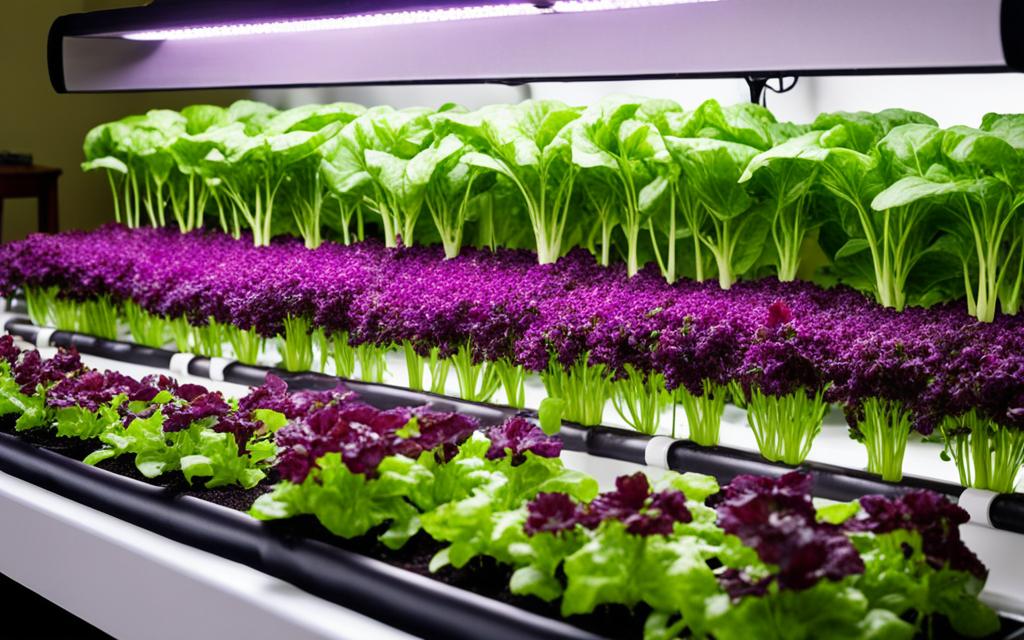
“Hydroponics allows us to grow vegetables and herbs in a sustainable, pesticide-free manner, while also extending the growing season and providing a reliable supply of nutrient-rich produce.”
Choosing the Right Hydroponic System
When starting a hydroponic vegetable garden, picking the right hydroponic system is key. You need to consider your space and what you want to grow. There are many options, each with its own benefits and things to think about. Let’s look at some common hydroponic systems to help you decide.
Deep Water Culture Systems
Deep Water Culture (DWC) systems are simple and efficient. They keep the plant roots in a water solution full of nutrients. This way, plants like lettuce, spinach, and berries get what they need to grow.
Nutrient Film Technique
The Nutrient Film Technique (NFT) is another popular choice. It uses a flow of nutrient-rich water through channels for the roots to absorb. This method is great for fast-growing plants like leafy greens and herbs because it keeps nutrient levels steady.
Ebb and Flow Systems
Ebb and Flow, or Flood and Drain, systems flood the grow beds with water and then drain it. This cycle is like the ocean’s tides, giving plants the right amount of moisture and nutrients. It’s good for a variety of crops, including peas, beans, and cucumbers.
| Hydroponic System | Key Features | Best Suited Crops |
|---|---|---|
| Deep Water Culture (DWC) | – Continuous nutrient access for plant roots – Simple setup and maintenance – Efficient for lightweight plants | Lettuce, spinach, berries |
| Nutrient Film Technique (NFT) | – Consistent nutrient delivery – Efficient water and nutrient usage – Ideal for fast-growing, lightweight plants | Leafy greens, herbs |
| Ebb and Flow | – Mimics natural tidal cycles – Suitable for a wide range of crops – Flexible and scalable system | Peas, beans, cucumbers |
Understanding the features and benefits of these systems helps you pick the best one for your garden. Think about the plants you want to grow, the space you have, and your experience level. This way, you can find a system that meets your gardening goals.
Setting Up Your Hydroponic Vegetable Garden
Starting a hydroponic vegetable garden means setting up your growing system right. Pick the best spot, build the needed infrastructure, and create the right environment. This ensures your plants stay healthy and productive. Let’s look at the main steps to set up your hydroponic garden for success.
Choosing the Right Location
Where you place your hydroponic garden is key. Find a spot that gets 6-8 hours of sunlight a day. If sunlight is scarce, use grow lights to help. Make sure the area is airy, has water and power for your gear, and gets enough light.
Constructing the Hydroponic System
The hydroponic system you pick affects your setup. You can choose from deep water culture, nutrient film technique, or ebb and flow systems. Each has its own setup needs, so pick what fits your space and needs. Follow the instructions to put together the trays, reservoirs, pumps, and other parts.
Establishing the Optimal Environment
Getting the environment right is crucial for healthy plants. Keep the water in your system at 65-75°F (18-24°C). Keep the nutrient solution’s pH between 5.5-6.5. Use the right grow lights for 15-20 hours a day. Check and adjust these things often to make the best space for your hydroponic veggies.
“Hydroponic gardening lets me grow fresh, pesticide-free food all year, right at home. Setting it up was easy, and the results are amazing.”
Think about the location, build your hydroponic system, and set up the best environment. You’ll be on your way to a great hydroponic vegetable garden. Next, we’ll cover the key equipment and supplies you need for your setup.
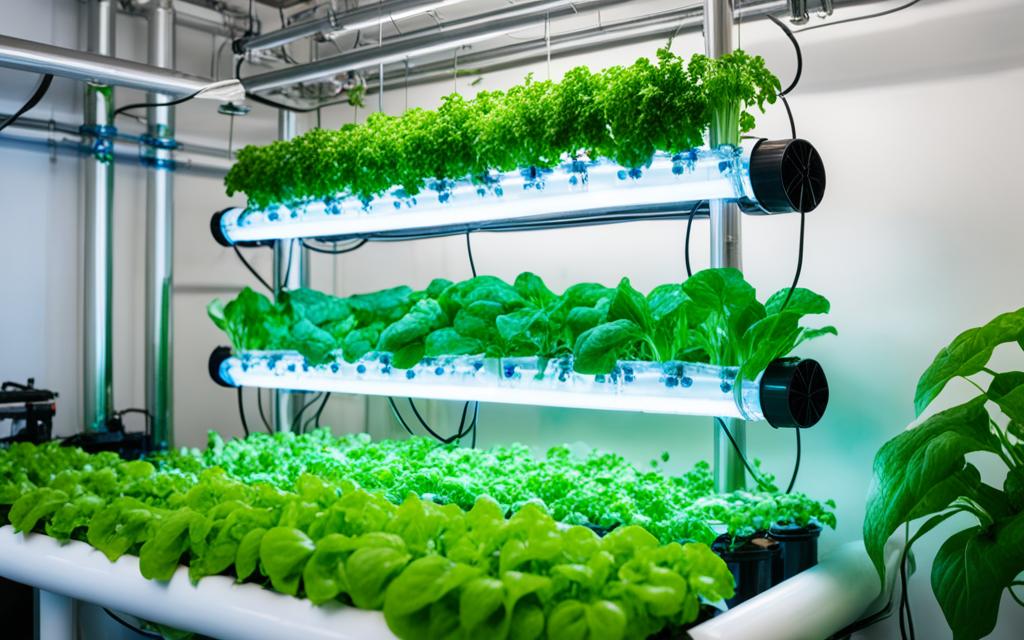
Essential Equipment and Supplies
To grow a successful hydroponic vegetable garden, you need the right equipment and supplies. At the core are grow lights and fixtures for lighting, and air pumps and air stones for oxygen. These items are crucial for a thriving setup.
Grow Lights and Fixtures
Sunlight is best for hydroponic plants, but many use high-efficiency LED grow lights instead. These lights mimic natural sunlight with their 4,000 to 6,000 Kelvin output. Over 70% of hydroponic system users count on LED grow light fixtures for their plants.
Air Pumps and Air Stones
Proper oxygenation is key for healthy hydroponic plants. Air pumps and stones help keep the nutrient solution moving and aerated. This ensures plants get the oxygen they need to grow well. About 50% of setups use air pumps and stones for good water and air flow.
Other important items for hydroponic gardening include reservoirs, growing media, monitoring tools, and special tools. With the right equipment and supplies, you can have a thriving vegetable garden at home.
“Hydroponic gardening lets me grow fresh, pesticide-free produce all year. The key is having the right equipment and supplies for my plants.”
hydroponic Vegetable Garden
When planning your hydroponic vegetable garden, picking the right varieties is key. Popular choices include leafy greens, herbs, tomatoes, peppers, and strawberries. These plants do well in hydroponic systems because of the controlled environment and nutrient-rich solutions.
Best Hydroponic Varieties for Vegetables
Leafy greens like lettuce, spinach, kale, and arugula are top picks for hydroponics. They grow fast and love the nutrient-rich solutions and controlled lights. Tomatoes and cucumbers also do great, especially American slicers, seedless cukes, and Lebanese cucumbers.
Peppers, like bell peppers, are another favorite. They often grow well with tomatoes in systems like DWC and Ebb and Flow. Green beans are also very productive, including pole beans that might need trellises or A-frames.
Microgreens are a great choice for beginners. They’re easy to grow and cost-effective.
Starting from Seeds vs. Transplants
Deciding between starting from seeds or using transplants is a big choice. Seeds let you control the growth from the beginning but take more time. Transplants give a head start but offer less control over the early stages.
Your choice depends on what you prefer, the veggies you’re growing, and what you have available. Whether you start with seeds or transplants, getting it right is key for a successful hydroponic garden.
| Hydroponic Vegetable Variety | Preferred Hydroponic System | Advantages |
|---|---|---|
| Leafy Greens (Lettuce, Spinach, Kale, Arugula) | Deep Water Culture (DWC) | Fast-growing, high yields, nutrient-rich |
| Tomatoes | Ebb and Flow, Deep Water Culture | Productive, flavorful, require significant light |
| Cucumbers | Ebb and Flow | Productive, various cultivars thrive |
| Bell Peppers | Deep Water Culture, Ebb and Flow | Nutrient-rich, high yields, versatile |
| Green Beans | Ebb and Flow | Highly productive, can use trellises |
| Microgreens | Various | Resilient, cost-effective, fast-growing |
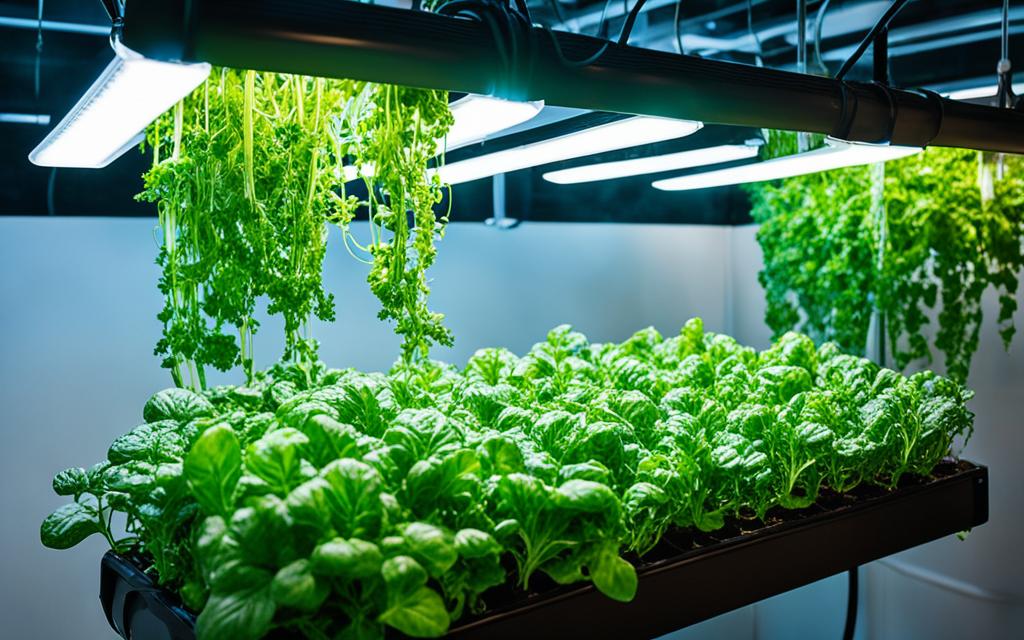
Remember, the best hydroponic varieties depend on your system and growing conditions. Try different plants and methods to find what works best for you.
Nutrient Management and pH Control
Getting hydroponic nutrient management and pH control right is key to a successful hydroponic garden. Plants need a balanced nutrient solution with essential macro- and micronutrients. It’s important to check and adjust the pH levels to help plants absorb nutrients well and stay healthy.
Essential Nutrients for Plant Growth
In hydroponics, managing nutrients means looking at total salt, pH, alkalinity, and nutrient ratios. Most of a plant is made up of carbon, hydrogen, and oxygen. The rest is essential nutrients, like:
- Nitrogen: 2-4%
- Sulfur: 0.50%
- Phosphorus: 0.40%
- Potassium: 2.00%
- Calcium: 1.50%
- Magnesium: 0.40%
Important micronutrients include manganese, iron, molybdenum, copper, zinc, boron, chlorine, and nickel. Keeping these nutrients in balance is vital for healthy plants in a hydroponic system.
Monitoring and Adjusting pH Levels
The ideal pH for hydroponic nutrient solutions is 5 to 6, with 5.5 best. High alkalinity can raise the pH, so it’s important to check and adjust with acidic fertilizers or reverse osmosis often.
Testing the pH regularly is a must, especially for beginners. Use electronic pH meters, litmus test strips, and liquid pH test kits to check the hydroponic water quality. Adjusting the pH after mixing and checking it often helps keep plants growing well.
“Proper nutrient management and pH control are the foundation of a thriving hydroponic vegetable garden.”
Light and Temperature Requirements
Hydroponic vegetable gardens need the right light and temperature to thrive. The type of grow lights and the temperature range are key for a healthy garden.
Types of Grow Lights for Hydroponic Gardens
Hydroponic grow lights mimic natural sunlight to help plants grow well. There are different types, each with its own benefits:
- High-Intensity Discharge (HID) Lights: HID lamps, like metal halide (MH) and high-pressure sodium (HPS) lights, are efficient and bright. They work well at different growth stages.
- Fluorescent Lights: Compact fluorescent lights (CFLs) and T5 fluorescent lights save energy and are great for the early growth stage in small setups.
- LED Grow Lights: LED lights are popular for their long life, saving energy, and customizable light colors. They can last up to 50,000 hours.
The best grow light depends on the garden’s size, the plants, and the budget.
Maintaining Optimal Temperature for Hydroponic Gardens
Hydroponic gardens also need the right temperature. The best water temperature is between 18°C and 25°C (65°F and 77°F). Temperatures under 20°C (68°F) can harm plants, and those over 25°C (77°F) can cause root rot.
Keeping the temperature right is crucial for systems like ebb and flow, aeroponics, and aquaponics. The right temperature helps plants grow, make food, and absorb nutrients. Automated systems like Growee can help adjust the water temperature for the best garden conditions.
Knowing about light and temperature needs helps growers create the best environment for their hydroponic gardens. This leads to healthy plants and more produce.
Integrated Technology for Optimal Growth
Technology has changed how we grow hydroponic vegetables. It gives us new tools and systems to make gardening better and easier. Real-time water quality checks and AI help plants grow better.
Real-Time Water Measurements
Keeping the right levels of nutrients and pH is key for healthy plants. Now, we can check water quality as it happens. This lets us see important things like pH, EC, and oxygen levels. We can then adjust these to help plants grow well.
AI-Powered Growth Assistance
AI has made growing plants easier. Smart systems use AI to look at your garden’s data. They give advice to make your plants grow better and taste better. They help with things like light, temperature, and nutrients, making gardening easier.
Using hydroponic technology, real-time water monitoring, and AI-powered hydroponic gardening, you can make a smart hydroponic system. This system makes growing your own food easy and fun. You’ll get lots of fresh produce and enjoy a healthy garden at home.
Common Issues and Troubleshooting
Even with the best practices, hydroponic gardeners may face problems like pests, diseases, and nutrient issues. It’s key to spot and fix these problems fast to keep your hydroponic garden healthy and productive.
Identifying and Addressing Pests and Diseases
Pests like Fungus gnats, Aphids, Whiteflies, Thrips, and Spider mites are common in hydroponics. Too many plants in one system can cause problems and hurt plant health. Algae can grow easily because of water, light, and nutrients.
Some plants, like peppers and tomatoes, need help pollinating to produce well. Root rot from Fungal diseases can badly harm plants.
To fight these problems, use integrated pest management and keep air moving well. Clean the system often. Natural insecticides like neem oil and garlic oil can control pests. For cleaning, use hydrogen peroxide or bleach solutions.
Nutrient Deficiencies and Solutions
Choosing the right hydroponic nutrients is key for plant health and avoiding system damage. Roots can clog pumps and tubing, causing problems. So, keep your system clean and well-maintained.
- The optimal pH level for most plants is between 5.5 and 6.5.
- The volume of the nutrient tank should not decrease by more than 20% per day to avoid salt build-up.
- An iron supplement should be added to the nutrient solution in cases of interveinal chlorosis.
- Potassium permanganate and copper sulfate can act as algaecides for cleaning algae from hydroponic systems.
- Nutrient lockout can result from pH levels being too high or too low, or from the nutrient solution being too strong, leading to salt buildup.
Keep an eye on pH and EC levels, and adjust the nutrient solution as needed. This helps fix nutrient issues and supports healthy plant growth.
Tips for Maximizing Yield and Quality
To get the best from your hydroponic garden, use techniques that maximize yields and improve quality. This means following best practices for pruning and training plants. It also means optimizing growing conditions.
Best Practices for Pruning and Training
Correct pruning and training of hydroponic plants boosts productivity and quality. Here are some tips:
- Remove dead, damaged, or diseased leaves and stems to promote healthy growth.
- Use techniques like topping, pinching, and trellising to shape the plant and use space well.
- Train vining crops like tomatoes and cucumbers to grow up supports for better light and air.
- Keep plants balanced by removing lower leaves and shoots, directing energy to the top.
Optimizing Environmental Factors
Improving your hydroponic setup’s environment is key for maximizing yields and improving quality. Consider these factors:
- Keep temperature, humidity, and air circulation right for plant growth.
- Use the right grow lights for photosynthesis and nutrient uptake.
- Check and adjust nutrient levels and pH in the solution for your plants.
- Use strong pest and disease management to protect your crops.
By using best practices for pruning, training, and optimizing the environment, you can make your hydroponic garden thrive. This way, you maximize yields and get the best produce.
Conclusion
Hydroponic vegetable gardening is a great way to grow fresh, nutrient-rich produce all year. It doesn’t need much outdoor space. By learning about its benefits, like pesticide-free and nutrient-rich harvests, people can grow their own food at home.
Choosing the right hydroponic system and managing the growing conditions well is key. This lets home gardeners grow a lot of fresh vegetables, herbs, and greens. Hydroponics uses up to 90% less water than traditional farming, which is great for areas with water shortages.
As the world’s population grows, hydroponic gardening is becoming more important. It helps meet the need for more food in a sustainable way. By using hydroponic technology, gardeners can help the environment and enjoy fresh, tasty produce right from their own gardens.
